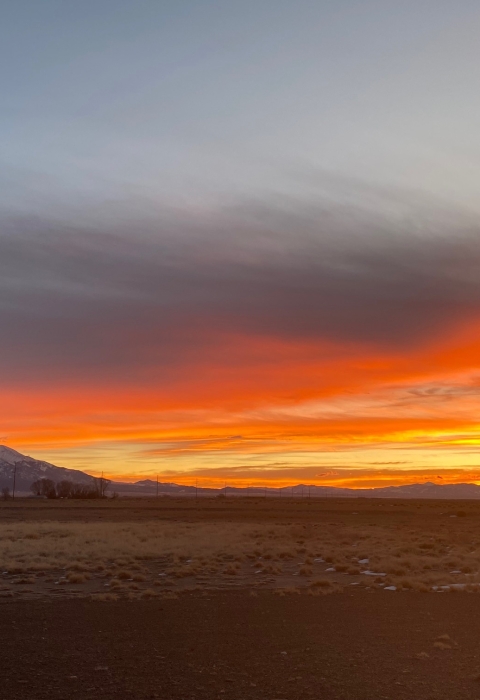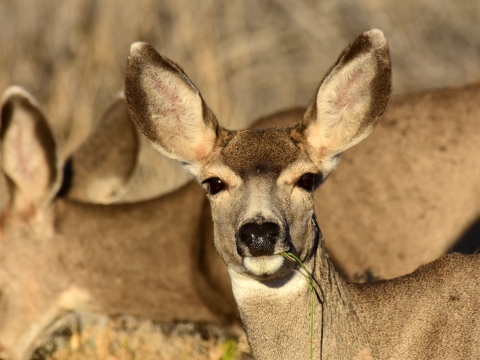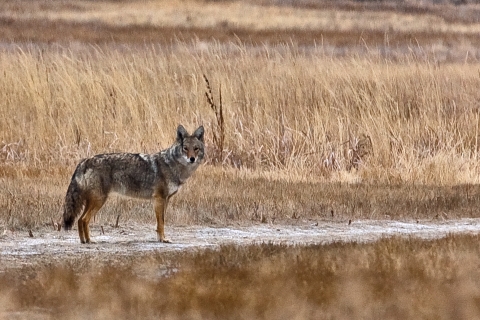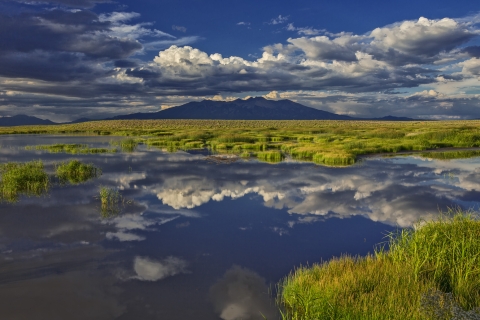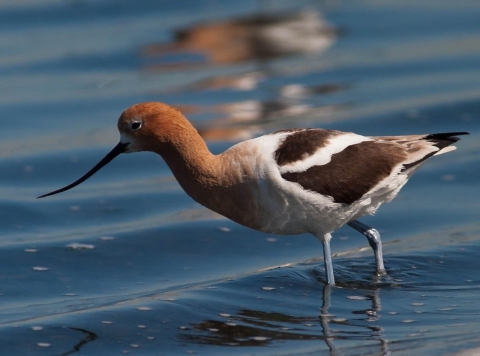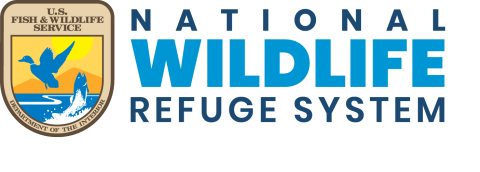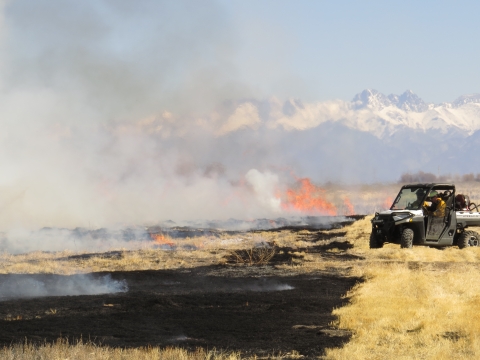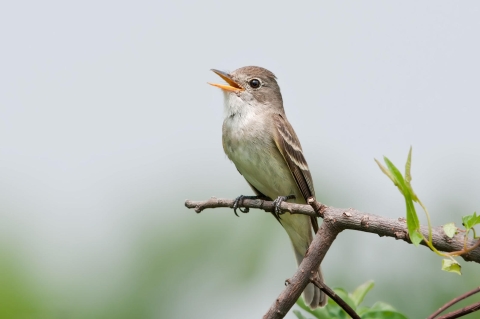Visit Us
Wildlife Viewing & Events (4/16/2024)
- Spring has sprung and the wetlands and riparian riparian
Definition of riparian habitat or riparian areas.
Learn more about riparian areas are starting to green up. Several species of migrating birds are singing and feeding throughout the refuge as they are continuing their northern migration or preparing for the mating season. - To protect the federally endagered Southwestern Willow Flycatcher, the Rio Grande Nature trail has been closed for the duration of the mating and nesting season.
- The Refuges Wildlife Drive is greening up nicely after our spring prescribed burn prescribed burn
A prescribed burn is the controlled use of fire to restore wildlife habitat, reduce wildfire risk, or achieve other habitat management goals. We have been using prescribed burn techniques to improve species habitat since the 1930s.
Learn more about prescribed burn . However, we are continuing to keep this unit dry so we can continue our cattail mitigation project later this summer. This project aims to set back the succession and encroachment of cattails within this unit. Too many cattails can choke out short emergent vegetation and become monocultured.
As a Reminder: Please respect all Refuge Boundaries, Rules & Regulations, and Closed Areas. These areas are there for wildlife and resource protection. If found inside closed areas or violating refuge regulations, Refuge Officers can and will issue citations.
Refuge Information
- The Refuge is open one hour before sunrise to one hour after sunset for Refuge permitted activities.
- Directions to the Refuge and Visitor Center -- From the junction of Hwy 17 and 160, drive east on HWY 160 for about 3 miles to El Rancho Lane. Turn right onto El Rancho and drive about 3/4 of a mile to the Refuge HQ Office and Vistor Contact Station. The visitor contact station is open intermittently when staff and volunteers are available. For more information, call us at 719-589-4021 or by email at alamosa@fws.gov.
- Alamosa & Monte Vista Refuge General Brochure
- San Luis Valley National Wildlife Refuge Complex | Facebook
- You can also contact Friends of the San Luis Valley Refuges for more information.
Know before you go:
When you plan for a trip to the Refuge, wear sturdy shoes for hiking and dress for the weather. Bringing water, food, binoculars, field guides, a hat, sunscreen, insect repellent, and anything else that might make the outdoor experience more enjoyable.
Location and Contact Information
About Us
About the Refuge
Alamosa National Wildlife Refuge was established in 1963 to provide food, cover, and breeding habitat for migratory birds and resident wildlife. The Refuge conserves and enhances the mixtures of wetland and desert habitats found in the area to accomplish these goals. Habitat management tools used on the Refuge include water and wetland management, weed control, haying, grazing, and prescribed fire.
The 12,026 acre Refuge is located at the south end of the San Luis Valley, a high mountain basin in south-central Colorado. It’s one of three national wildlife refuges in the Valley that provide crucial feeding, resting, and breeding habitat for over 200 bird species and other wildlife. The San Luis Valley, sitting at 7,800 feet, extends over 100 miles from north to south and 50 miles from east to west. Three mountain ranges surround it – the Sangre de Christo to the east, the San Juan to the west, and the Saguache to the north. At sunset, the high peaks of the Sangre de Christo take on the blood red glow which inspired the Spanish explorers to name the range “Blood of Christ.” The surrounding mountains feed the arid valley with precious surface water and replenish an underground reservoir. The mountain snow melt and artesian wells provide needed water to the agricultural community and to the rivers, creeks, and wetlands that thread across the valley floor. The Refuge lies within the Rio Grande floodplain and consists of wet meadows, old river oxbows, riparian riparian
Definition of riparian habitat or riparian areas.
Learn more about riparian corridors, and dry uplands. These diverse habitats support a multitude of songbirds, water birds, waterfowl, raptors, mule deer, beavers, and coyotes. The west side of the Refuge borders the Rio Grande, long considered to be the life blood of the San Luis Valley. Water from the Rio Grande maintain these important habitats.
About the Complex
Alamosa, Monte Vista, and Baca National Wildlife Refuges are areas set aside for migratory birds and resident wildlife. The Refuges are now combined administratively into the San Luis Valley National Wildlife Refuge Complex. The 12,026 acre Alamosa Refuge includes wetland areas, riparian corridors, wet meadows, and river oxbows. The wetland and river habitats provide a wildlife oasis in this dry region. These habitats support a variety of wildlife, including songbirds, water birds, raptors, deer, beavers, coyotes, and more.
The artificially created wetlands on the 14,804 acre Monte Vista Refuge are intensively managed to provide habitat for a wide variety of waterfowl and other water birds. Mallards, pintails, teals, and Canada geese are common, as are American avocets, killdeers, white-faced ibises, egrets, and herons. Irrigation canals and wells provide precious water to maintain this important wetland habitat.
The 92,500 acre Baca Refuge is a highly diverse combination of shrublands, grasslands, wet meadows, playa wetlands, and riparian areas. This Refuge was set aside not only as another haven for migratory birds and resident wildlife, but also as an important piece in a broader conservation effort to protect the wildlife, habitat, and water of the north and east portions of the San Luis Valley. These three refuges of the San Luis Valley National Wildlife Refuge Complex contribute to over 560 refuges in the National Wildlife Refuge System – a network of lands set aside and managed by the U.S. Fish and Wildlife Service specifically for wildlife. The National Wildlife Refuge System is a living heritage, conserving wildlife and habitat for people today and generations to come.
What We Do
U.S. FISH & WILDLIFE SERVICE
San Luis Valley National Wildlife Refuge Complex
7824 El Rancho Lane
Alamosa, Colorado 81101
For Immediate Release
3/13/2024
Prescribed Burns Planned
Alamosa, Baca, & Monte Vista National Wildlife Refuges
Contact: Dean Lee, (719) 589-4021 x1008, Dean_Lee@fws.gov
Alamosa, CO – The U.S. Fish and Wildlife Service will be conducting prescribed fire operations on the Alamosa, Baca, and Monte Vista National Wildlife Refuges to remove old and matted vegetation to improve wildlife habitat. Additionally, slash piles of natural materials will be burned as conditions and needs exist. Professional fire personnel from the U.S. Fish & Wildlife Service Mid-Plains Fire Zone, State, and Federal Partners will conduct the fire operations. Planned target dates for burning will be during the months of March and April and again in October and November 2024. The Refuges’ Auto Tour Routes and Walking Trails may be temporarily closed to the public during fire operations for safety concerns. For your safety, please avoid these areas! Areas will re-open as soon as possible based on fire activity and safety.
Smoke will be visible to local residents, towns, and highways during the day and may last for a few days following burning operations. Signs will be posted along the nearest major roads and all burns will be monitored until they are declared completely out.
For up-to-date information, you may contact Alamosa and Monte Vista Refuge Manager Suzanne Beauchaine (719) 589-4021 x1003 or Assistant Refuge Manager Dean Lee (719) 589-4021 x1008, or Baca Refuge Manager Ty Benally (719) 256-5527.
Additional information can be found on our San Luis Valley National Wildlife Refuge Complex Facebook page at http://www.facebook.com/SanLuisValleyRefugeComplex
Prescribed fire smoke may affect your health. For more information see https://www.colorado.gov/pacific/cdphe/wood-smoke-and-health
– FWS –
Our Species
Southwestern Willow Flycatcher
The southwestern willow flycatcher is a small, neo-tropical, migrating bird found in areas of the southwest United States and as far down as South America. Their primary habitat is dense thickets of trees and shrubs along riparian riparian
Definition of riparian habitat or riparian areas.
Learn more about riparian corridors of rivers and streams, especially willow thickets. They typically breed and nest in the southwestern states of Arizona, California, New Mexico, and portions of southwestern Colorado. However, due to habitat loss and fragmentation from drought, stream channelization, and water diversions for agriculture and urban development, the population declined drastically. In 1995, the U.S. Fish & Wildlife Service listed the southwestern willow flycatcher as a federally endangered species and began recovery plan efforts. In 2002, the Southwestern Willow Flycatcher Recovery Plan was finalized, which paved the way for habitat restoration and critical habitat designation.
On Alamosa National Wildlife Refuge, the southwestern willow flycatcher historically inhabited the vast amount of willow and other riparian habitats found along the Rio Grande. However, in the early 2000's the Rio Grande Basin experienced the worst drought on record. This resulted in severely degraded willow habitat throughout the Refuge. The southwestern willow flycatcher population was immediately impacted and survey numbers indicated a drop from 29 territories in 1997 to only 3 territories in 2010 (Owen and Sogge 1997). The U.S. Fish and Wildlife Service took action and designated critical habitat for the entire riparian habitat along the Rio Grande on the Refuge. This action prohibits any disturbance to this designated habitat to insure southwestern willow flycatcher population recovery. Other actions taken were the seasonal closure of the Rio Grande Nature Trail and certain portions of the Refuge's public fishing access area from April 15th through August 31st.
